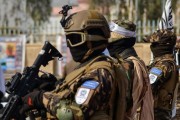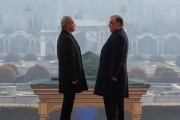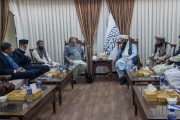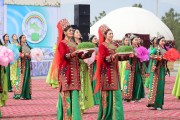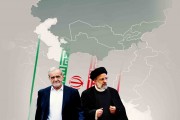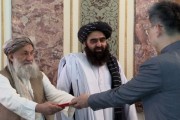Publish Date
Thursday 15 April 2021 - 10:40
recommended
0
The Istanbul Conference; Bargaining over a 2 or 3 sided Afghan peace equation
For Afghanistan, the Istanbul Conference is just like the Bonn Conference in 2001. The conference - to be held by the United Nations in cooperation with regional countries and the United States - is scheduled to be hosted by Turkey in late April. The prominent role of the regional countries, United States and United Nations in this conference have distinguished it from other peace negotiations in recent years. Although the suggestions put forward by the non-Taliban side, including the government and political parties, are numerous, one can summarize them into four main parameters: ceasefire, transitional peace government, structure of the next system, and preservation of the existing values. From the perspective of the Afghan political parties, a “permanent ceasefire” and a “fair political participation in power” are the two main issues in the Istanbul Conference which are prioritized as follows: anything that reduces or removes fair participation from the power structure is unacceptable, even if it leads to continuation of war in Afghanistan. The political parties and institutions have proposed a triangular model for having an effective role in the peace transitional government, with the government on one side, the Taliban on the other, and the political parties on the third side. But from the Taliban's point of view, this model is not acceptable, because they put all the republicans in a single front and so believe in a two-sided model.
By: Abdulrahim Kamel
Introduction
For Afghanistan, the Istanbul Conference is just like the Bonn Conference in 2001. The conference, leading by the United Nations in cooperation with the regional countries and the United States, is scheduled to be hosted by Turkey in April. The prominent role of the regional countries, United States and United Nations in this conference have distinguished it from other peace negotiations in recent years.
In order to prepare the ground for the conference, the Afghan political figures and institutions must submit their proposals to a 15-member committee chaired by Yunus Qanuni in the Afghan High Peace Council, where they are supposed to unite different plans and finally, a single will plan be presented by the Islamic Republic of Afghanistan to the Istanbul Conference.
These plans are somehow in line with the US government's proposal for the Afghan peace process. The plan presented by the US government caused a lot of sensitivity among the political community and the Afghan government. So Zalmay Khalilzad finally accepted that the plan is a mere proposal and the other parties can present their own version.
Although the plans presented by the political community and the government of Afghanistan are numerous, the four main parameters of these plans are: ceasefire, transitional peace government, structure of the next system, and preservation of the existing values.
But, the approaches of the Afghan government, personalities and political institutions are different in terms of prioritization and the operational mechanism. Undoubtedly, the main focus of the Istanbul Conference is on the operational mechanism of these plans, which would be also the most challenging part. In this article, we will discuss about this issue and evaluate the main approaches, priorities and concerns of the political parties, the Afghan government and the United States at the Istanbul Conference.
The approach of the political parties and institutions
The main concerns of the political parties and institutions in the Istanbul conference are two things: A permanent ceasefire and fair political participation in power.
Among these two priorities, anything that diminishes or eliminates the principle of fair participation in the power structure is unacceptable, even if it leads to continuation of war in Afghanistan.
This approach of the political parties and institutions stems from the interaction and tolerance that they exercised at the Bonn conference in 2001. In fact, the political parties and figures were looking for an opportunity to change Bonn's unprincipled cornerstone. The political parties and institutions, especially the non-Pashtun ethnic groups, consider the current structure of the power in Afghanistan (i.e. a centralized structure) as one of the factors limiting their balanced presence in the body of the political power.
So, a ceasefire would be the common demand of all parties at the Istanbul Conference. But, regarding other issues such as the transitional peace government, structure of the next system, and preservation of the existing values, all parties and ethnic figures seek a mechanism that can guarantee the participation of the people and political entities in the body of the national power.
For this group, the main priorities include:
Introduction
For Afghanistan, the Istanbul Conference is just like the Bonn Conference in 2001. The conference, leading by the United Nations in cooperation with the regional countries and the United States, is scheduled to be hosted by Turkey in April. The prominent role of the regional countries, United States and United Nations in this conference have distinguished it from other peace negotiations in recent years.
In order to prepare the ground for the conference, the Afghan political figures and institutions must submit their proposals to a 15-member committee chaired by Yunus Qanuni in the Afghan High Peace Council, where they are supposed to unite different plans and finally, a single will plan be presented by the Islamic Republic of Afghanistan to the Istanbul Conference.
These plans are somehow in line with the US government's proposal for the Afghan peace process. The plan presented by the US government caused a lot of sensitivity among the political community and the Afghan government. So Zalmay Khalilzad finally accepted that the plan is a mere proposal and the other parties can present their own version.
Although the plans presented by the political community and the government of Afghanistan are numerous, the four main parameters of these plans are: ceasefire, transitional peace government, structure of the next system, and preservation of the existing values.
But, the approaches of the Afghan government, personalities and political institutions are different in terms of prioritization and the operational mechanism. Undoubtedly, the main focus of the Istanbul Conference is on the operational mechanism of these plans, which would be also the most challenging part. In this article, we will discuss about this issue and evaluate the main approaches, priorities and concerns of the political parties, the Afghan government and the United States at the Istanbul Conference.
The approach of the political parties and institutions
The main concerns of the political parties and institutions in the Istanbul conference are two things: A permanent ceasefire and fair political participation in power.
Among these two priorities, anything that diminishes or eliminates the principle of fair participation in the power structure is unacceptable, even if it leads to continuation of war in Afghanistan.
This approach of the political parties and institutions stems from the interaction and tolerance that they exercised at the Bonn conference in 2001. In fact, the political parties and figures were looking for an opportunity to change Bonn's unprincipled cornerstone. The political parties and institutions, especially the non-Pashtun ethnic groups, consider the current structure of the power in Afghanistan (i.e. a centralized structure) as one of the factors limiting their balanced presence in the body of the political power.
So, a ceasefire would be the common demand of all parties at the Istanbul Conference. But, regarding other issues such as the transitional peace government, structure of the next system, and preservation of the existing values, all parties and ethnic figures seek a mechanism that can guarantee the participation of the people and political entities in the body of the national power.
For this group, the main priorities include:
a balanced and fair presence of all parties in the transitional peace government;
the type of the political structure that is preferably a republican one and is decentralized;
And preservation of the civic values, especially election.
Therefore, it can be summarized that for the vast majority of the political factions in Afghanistan, the abolition of the current elected government headed by Ashraf Ghani and formation of an interim transitional government is not an issue. The suspension of the current constitution is not an issue too, because they see the current constitution as a source of political concentration which limits their presence in the national power. What is important is a balanced participation in the country's post-peace political power.
Hence, it seems that the plans presented by the political parties and institutions can be easily unified and recount by different parties in the negotiations. However, the problem of this group cannot be solved only through a single plan and multiple theoretical sounds.
The main challenge is when the political factions move quickly and agilely from the first stage to the next one. In other words, the discussion about the structure of the future system of Afghanistan (centralized or decentralized; presidential or parliamentary) would be the topic of the next stage, which is discussed at the time of drafting the new constitution under a transitional government. It is not clear what the situation of the political parties and institutions would be following the formation of a peace transitional government with the presence of the Taliban, and how much bargaining power and leverage they will have.
In the transitional peace government, the Taliban Certainly will have a more prominent role than the political parties, otherwise they will have no desire to end the war in Afghanistan. Moreover, following the integration of a part of the Taliban's military forces into the government forces, they will be present in Afghan politics in the form of a political and social structure. In this context, they will have a stronger presence in both political and military structures of the transitional government and will impose more pressure during the process of drafting the next constitution.
For an effective presence in the peace transitional government, the political parties and institutions have proposed a triangular model, with the government on one side, the Taliban on the other, and political parties on the third side. But from the Taliban's point of view, this model is not acceptable, because they believe that all the republicans must be put in a single front and so propose a two-sided model.
It is because of these concerns that the government plan led by Ashraf Ghani, while having similar principles and priorities, has been portrayed differently in terms of priorities and operational mechanism.
The approach of the Afghan government
The Afghan government, led by Ashraf Ghani and his allies, will also insist on these four principles at the Istanbul conference, but there would be a noticeable disagreement over the methods of implementation. Although the government's plan has not been made public so far, the details that have been leaked to the media about the government plan clearly shows that it has four basic principles, which are:
the type of the political structure that is preferably a republican one and is decentralized;
And preservation of the civic values, especially election.
Therefore, it can be summarized that for the vast majority of the political factions in Afghanistan, the abolition of the current elected government headed by Ashraf Ghani and formation of an interim transitional government is not an issue. The suspension of the current constitution is not an issue too, because they see the current constitution as a source of political concentration which limits their presence in the national power. What is important is a balanced participation in the country's post-peace political power.
Hence, it seems that the plans presented by the political parties and institutions can be easily unified and recount by different parties in the negotiations. However, the problem of this group cannot be solved only through a single plan and multiple theoretical sounds.
The main challenge is when the political factions move quickly and agilely from the first stage to the next one. In other words, the discussion about the structure of the future system of Afghanistan (centralized or decentralized; presidential or parliamentary) would be the topic of the next stage, which is discussed at the time of drafting the new constitution under a transitional government. It is not clear what the situation of the political parties and institutions would be following the formation of a peace transitional government with the presence of the Taliban, and how much bargaining power and leverage they will have.
In the transitional peace government, the Taliban Certainly will have a more prominent role than the political parties, otherwise they will have no desire to end the war in Afghanistan. Moreover, following the integration of a part of the Taliban's military forces into the government forces, they will be present in Afghan politics in the form of a political and social structure. In this context, they will have a stronger presence in both political and military structures of the transitional government and will impose more pressure during the process of drafting the next constitution.
For an effective presence in the peace transitional government, the political parties and institutions have proposed a triangular model, with the government on one side, the Taliban on the other, and political parties on the third side. But from the Taliban's point of view, this model is not acceptable, because they believe that all the republicans must be put in a single front and so propose a two-sided model.
It is because of these concerns that the government plan led by Ashraf Ghani, while having similar principles and priorities, has been portrayed differently in terms of priorities and operational mechanism.
The approach of the Afghan government
The Afghan government, led by Ashraf Ghani and his allies, will also insist on these four principles at the Istanbul conference, but there would be a noticeable disagreement over the methods of implementation. Although the government's plan has not been made public so far, the details that have been leaked to the media about the government plan clearly shows that it has four basic principles, which are:
A general ceasefire.
Establish a participatory peace government in which the Taliban are represented in the current government structure through a political agreement; Not that the current government step down and an interim government be created.
Holding an early election under the supervision of the United Nations to hand over the power from a participatory peace government to the next elected government.
Finally, the most important issue is preservation of the existing values, especially the constitution, through making the necessary adjustments following the peace agreement.
Establish a participatory peace government in which the Taliban are represented in the current government structure through a political agreement; Not that the current government step down and an interim government be created.
Holding an early election under the supervision of the United Nations to hand over the power from a participatory peace government to the next elected government.
Finally, the most important issue is preservation of the existing values, especially the constitution, through making the necessary adjustments following the peace agreement.
The government of Afghanistan has introduced the early elections and preservation or "amendment" of the constitution as its red line in order to make sure about the future course as well as better implementation of the peace agreement.
For Ashraf Ghani, it is natural that maintaining the current system takes precedence over how to participate and share power in the future. The Taliban have so far opposed this idea. Other political opposition parties are also dissatisfied with the prolongation of Ghani's term and also have unpleasant memories from the past election.
The government's argument is that the Taliban are unreliable and uncivilized, hence, an imposed civilization cannot force them to behave in a civilized manner. Therefore, according to Ghani, if the current government is overthrown, there would be no guarantee that the Taliban abide by the peace talks and avoid a coup.
It is probably based on this approach that the Afghan government has a separate and specific view towards the implementation of the principles of the peace process.
Only the European Union and India clearly understand the concerns of the Afghan government. They consider the cessation of the system as the cessation of Afghanistan's civic values and achievements.
The worrying point about the government and the political parties is that both of them are preparing their plans in a climate of fear. Neither of them know how much of their demands will be taken into account. Their plans may have been technically reviewed, but the main audience, the Afghan people, are unaware of them. In fact, following the people turnout in the last election, there now seems to be an atmosphere in Afghanistan where the government and political institutions are forced to be accountable to regional and American powers rather than to the people.
The US approach
The US government insists on ceasefire, among the four key principles mentioned in the peace talks. This is not a new approach. Since the start of the peace talks between the United States and the Taliban two years ago, Zalmay Khalilzad has repeatedly stated in the media that it is up to the Afghan people to decide about the preservation of values and type of their future political system.
Even now, at the Istanbul conference, the United States will emphasize on the ceasefire issue and formation of a transitional peace government. It seems that the United States will try to persuade the Afghan parties and regional countries to agree on a ceasefire and the establishment of a transitional government, but its mechanism is still unclear.
The US is working to clarify the status of peace talks before the deadline for the withdrawal of the US troops from Afghanistan expires in May. This would allow Washington to decide whether to leave the country or stay there through another agreement.
On the other hand, The Taliban are procrastinating to attend the Istanbul conference in order to extract more concessions via the approaching deadline.
Given to the spirit and management approach of the Istanbul Conference, convincing the warring parties in Afghanistan does not seem easy. It is clear from the tone of the US statements that it will use the threat option more, in a bid to force the Taliban as well as the Afghan Government and political institutions to reach a political agreement over the establishment of a government, and so the issue of the war and presence of American troops in Afghanistan be resolved somehow. This approach, however, does not seem very promising.
Conclusion
As it turns out, despite the US pressures, the Afghan government will not back down this time. The opposition factions, the Taliban and the United States insist on resolving the issues through a transitional government. But the Afghan government, in the most optimistic conditions, accepts a participatory peace government in which the Taliban are represented in the current government structure.
This shows that the distance is too long. If the Taliban wanted to join the current government, it would not have missed the opportunity years ago. Now that the United States is waiting to leave Afghanistan and the Taliban has progressed diplomatically, it is highly unlikely that the group integrates itself into the current government.
The situation suggests that the peace talks would lead nowhere at the Istanbul Conference, and an Istanbul Conference II will be proposed. With this forecast, the withdrawal of US troops from Afghanistan will also be delayed.
Abdul Rahim Kamel, is an Afghan analyst and writer
For Ashraf Ghani, it is natural that maintaining the current system takes precedence over how to participate and share power in the future. The Taliban have so far opposed this idea. Other political opposition parties are also dissatisfied with the prolongation of Ghani's term and also have unpleasant memories from the past election.
The government's argument is that the Taliban are unreliable and uncivilized, hence, an imposed civilization cannot force them to behave in a civilized manner. Therefore, according to Ghani, if the current government is overthrown, there would be no guarantee that the Taliban abide by the peace talks and avoid a coup.
It is probably based on this approach that the Afghan government has a separate and specific view towards the implementation of the principles of the peace process.
Only the European Union and India clearly understand the concerns of the Afghan government. They consider the cessation of the system as the cessation of Afghanistan's civic values and achievements.
The worrying point about the government and the political parties is that both of them are preparing their plans in a climate of fear. Neither of them know how much of their demands will be taken into account. Their plans may have been technically reviewed, but the main audience, the Afghan people, are unaware of them. In fact, following the people turnout in the last election, there now seems to be an atmosphere in Afghanistan where the government and political institutions are forced to be accountable to regional and American powers rather than to the people.
The US approach
The US government insists on ceasefire, among the four key principles mentioned in the peace talks. This is not a new approach. Since the start of the peace talks between the United States and the Taliban two years ago, Zalmay Khalilzad has repeatedly stated in the media that it is up to the Afghan people to decide about the preservation of values and type of their future political system.
Even now, at the Istanbul conference, the United States will emphasize on the ceasefire issue and formation of a transitional peace government. It seems that the United States will try to persuade the Afghan parties and regional countries to agree on a ceasefire and the establishment of a transitional government, but its mechanism is still unclear.
The US is working to clarify the status of peace talks before the deadline for the withdrawal of the US troops from Afghanistan expires in May. This would allow Washington to decide whether to leave the country or stay there through another agreement.
On the other hand, The Taliban are procrastinating to attend the Istanbul conference in order to extract more concessions via the approaching deadline.
Given to the spirit and management approach of the Istanbul Conference, convincing the warring parties in Afghanistan does not seem easy. It is clear from the tone of the US statements that it will use the threat option more, in a bid to force the Taliban as well as the Afghan Government and political institutions to reach a political agreement over the establishment of a government, and so the issue of the war and presence of American troops in Afghanistan be resolved somehow. This approach, however, does not seem very promising.
Conclusion
As it turns out, despite the US pressures, the Afghan government will not back down this time. The opposition factions, the Taliban and the United States insist on resolving the issues through a transitional government. But the Afghan government, in the most optimistic conditions, accepts a participatory peace government in which the Taliban are represented in the current government structure.
This shows that the distance is too long. If the Taliban wanted to join the current government, it would not have missed the opportunity years ago. Now that the United States is waiting to leave Afghanistan and the Taliban has progressed diplomatically, it is highly unlikely that the group integrates itself into the current government.
The situation suggests that the peace talks would lead nowhere at the Istanbul Conference, and an Istanbul Conference II will be proposed. With this forecast, the withdrawal of US troops from Afghanistan will also be delayed.
Abdul Rahim Kamel, is an Afghan analyst and writer
News code:2611





